1997 CHEVROLET CORVETTE climate control
[x] Cancel search: climate controlPage 86 of 356
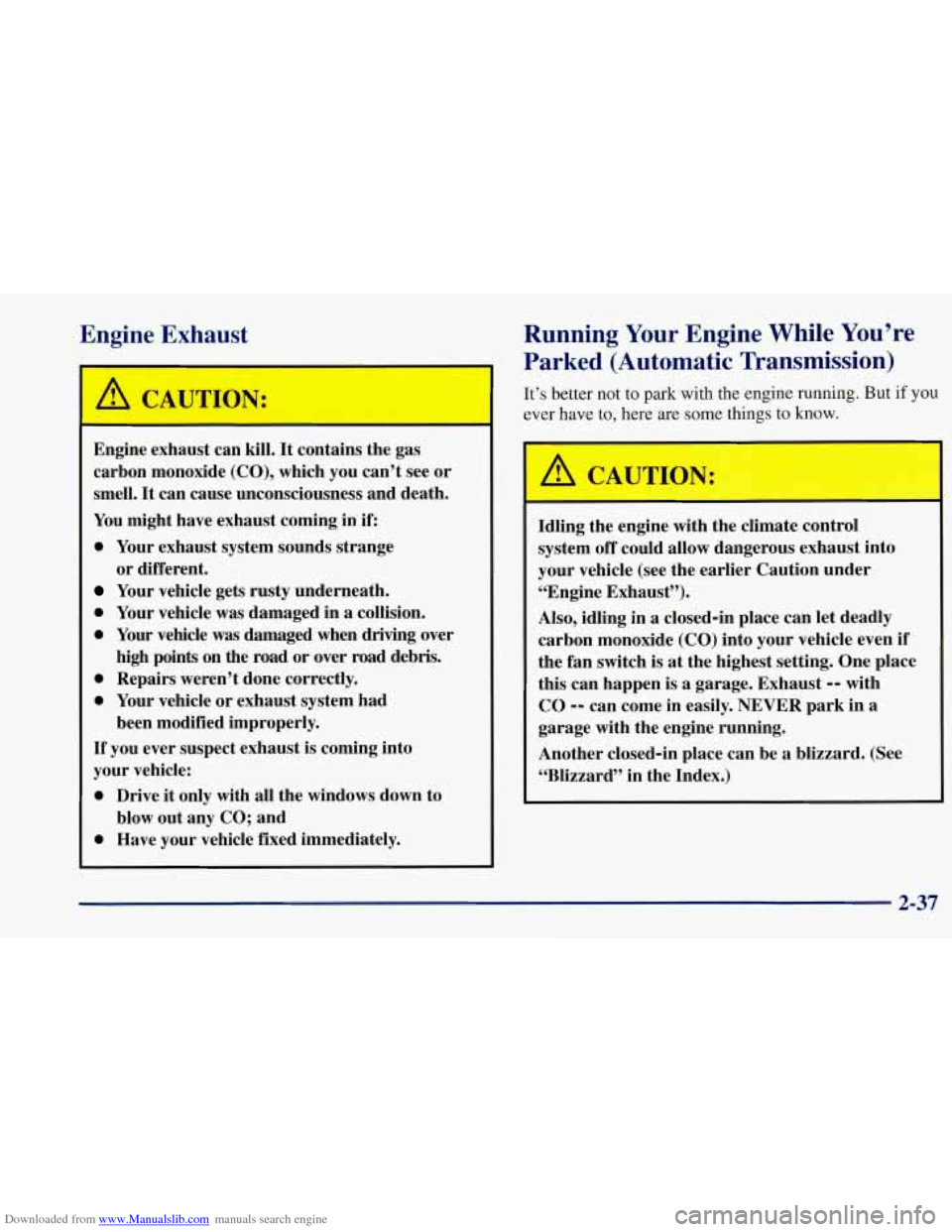
Downloaded from www.Manualslib.com manuals search engine Engine Exhaust
Engine exhaust can kill. It contains the gas
carbon monoxide (CO), which you can’t see or
smell. It can cause unconsciousness and death.
You might have exhaust coming in if:
0 Your exhaust system sounds strange
Your vehicle gets rusty underneath.
0 Your vehicle was damaged in a collision.
0 Your vehicle was damaged when driving over
high points on the road or over road debris.
0 Repairs weren’t done correctly.
0 Your vehicle or exhaust system had
If you ever suspect exhaust is coming into
your vehicle:
0 Drive it only with all the windows down to
0 Have your vehicle fixed immediately.
or
different.
been modified improperly.
blow out any CO; and
Running Your Engine While You’re
Parked (Automatic Transmission)
It’s better not to park with the engine running. But if you
ever Pn- to, hern ?re SOT? thingr tn know.
Idling the engine with the climate control
system off could allow dangerous exhaust into
your vehicle (see the earlier Caution under
“Engine Exhaust”).
Also, idling in
a closed-in place can let deadly
carbon monoxide (CO) into your vehicle even if
the fan switch is at the highest setting. One place
this can happen is
a garage. Exhaust -- with
CO
-- can come in easily. NEVER park in a
garage with the engine running.
Another closed-in place can be
a blizzard. (See
“Blizzard” in the Index.)
2-37
Page 148 of 356

Downloaded from www.Manualslib.com manuals search engine e Section 3 Comfort Controls and Audio Systems
In this section, you’ll find out how to operate the comfort control and audio systems offered with your Corvette. Be
sure to read about the particular systems supplied with your vehicle.
3-2
3-2
3-5
3-1 1
3-12
3-12
3-13
3-13
3-14 Comfort Controls
Manual Comfort
Controls
Automatic Electronic Dual Climate
Control System (Option)
Air Conditioning
Heating
Defogging and Defrosting
Audio Systems
Setting the Clock for All Systems
AM-FM Stereo with Cassette Tape Player
Automatic Tone Control and 3-18
3-18
3
-22
3 -26
3 -28
3-28
3-29
3-30
3-30 CD
Adapter Kits
AM-FM Stereo with Compact Disc Player
and Automatic Tone Control (Option)
Trunk Mounted CD Changer (Option)
Theft-Deterrent Feature
Understanding Radio Reception
Tips About Your Audio System
Care of Your Cassette Tape Player
Care of Your Compact Discs
Integrated Windshield and Rear
Window Antennas
3-1
Page 152 of 356
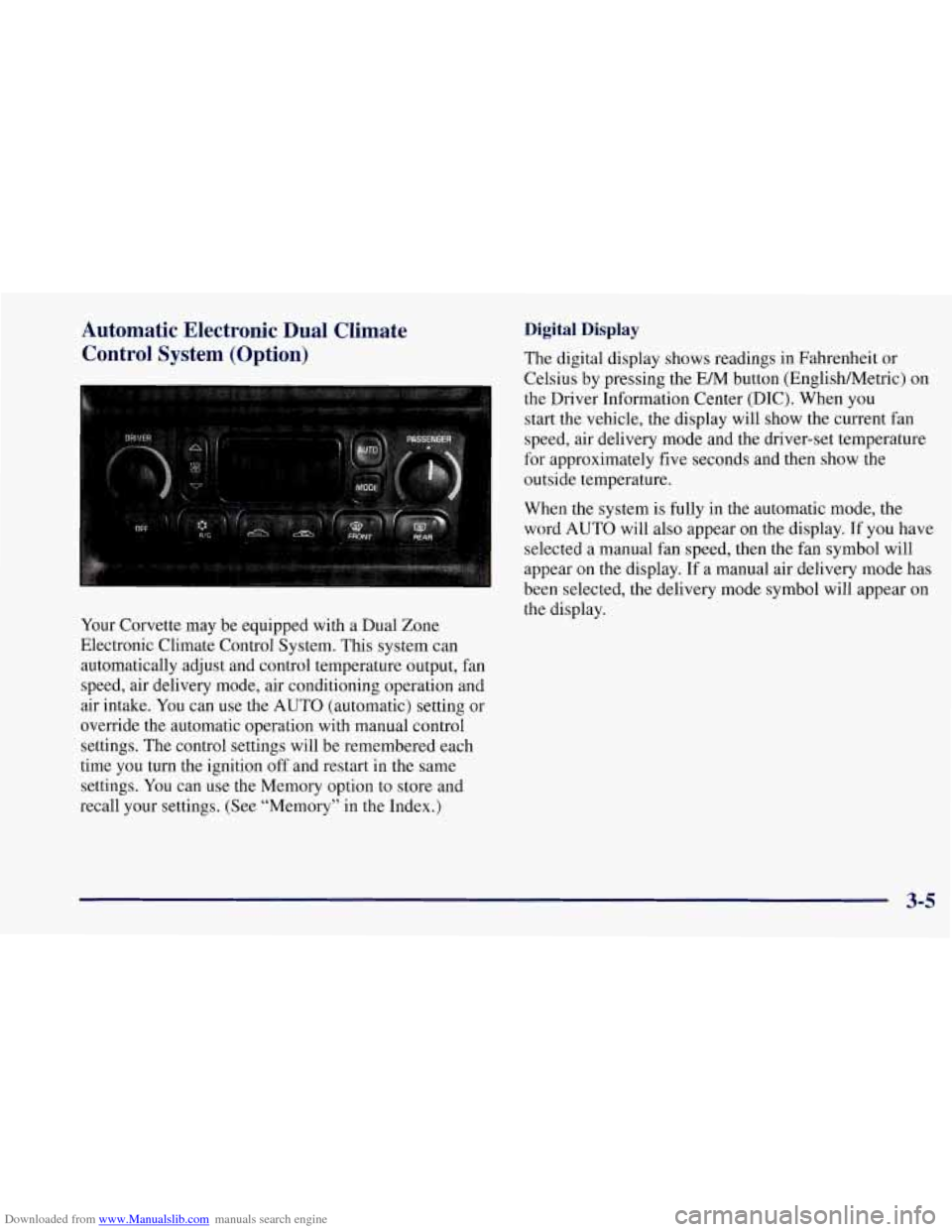
Downloaded from www.Manualslib.com manuals search engine Automatic Electronic Dual Climate Control System (Option)
Your Corvette may be equipped with a Dual Zone
Electronic Climate Control System. This system can
automatically adjust and control temperature output, fan
speed, air delivery mode, air conditioning operation and
air intake. You can. use the AUTO (automatic) setting or
override the automatic operation with manual control
settings. The control settings will be remembered each
time you turn the ignition
off and restart in the same
settings.
You can use the Memory option to store and
recall your settings. (See “Memory” in the Index.)
Digital Display
The digital display shows readings in Fahrenheit or
Celsius by pressing the
EM button (EnglishlMetric) on
the Driver Information Center (DIC). When you
start the vehicle, the display will show the current fan
speed, air delivery mode and the driver-set temperature
for approximately five seconds and then show the
outside temperature.
When the system is fully in the automatic mode, the
word AUTO will also appear on the display.
If you have
selected
a manual fan speed, then the fan symbol will
appear on the display.
If a manual air delivery mode has
been selected, the delivery mode symbol will appear
on
the display.
3-5
Page 155 of 356
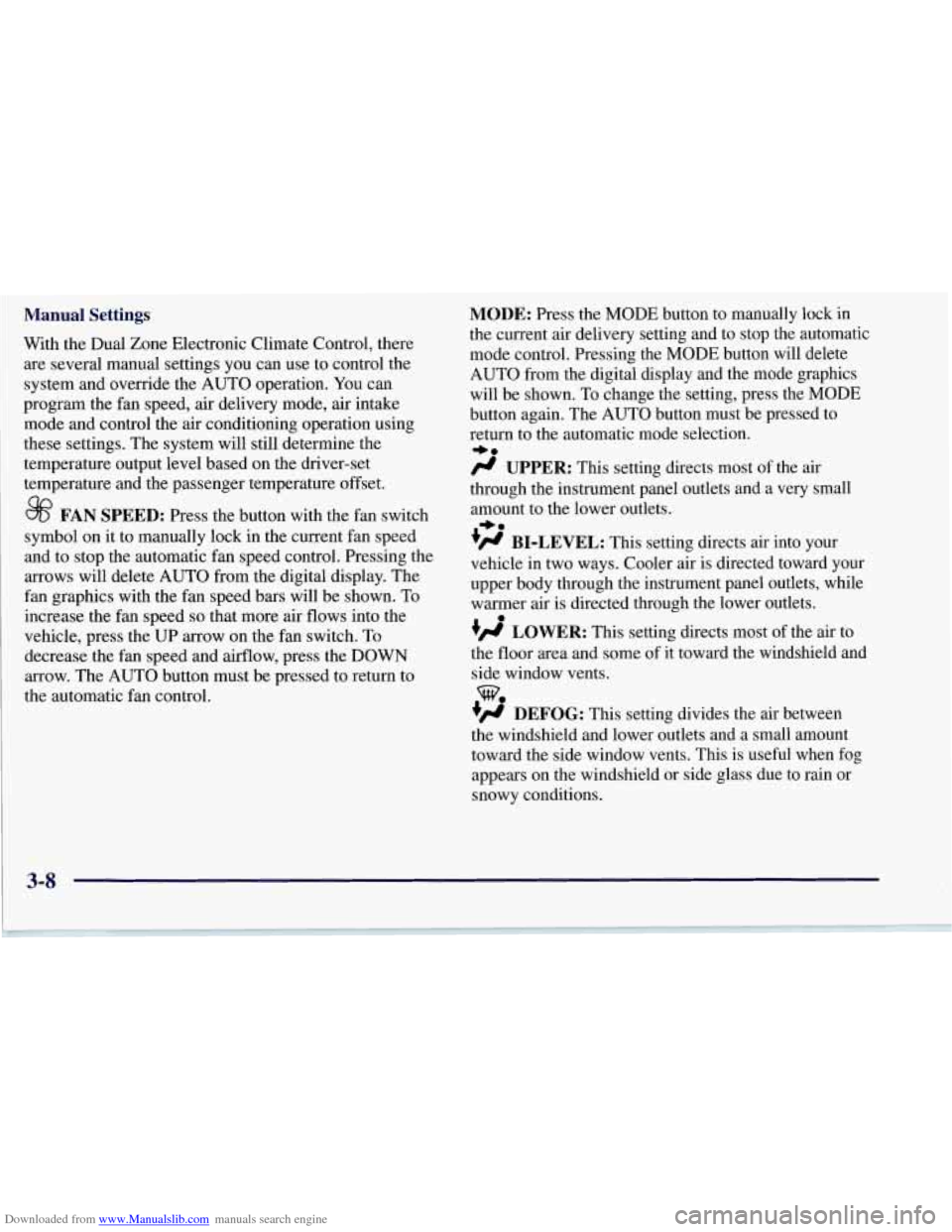
Downloaded from www.Manualslib.com manuals search engine Manual Settings
With the Dual Zone Electronic Climate Control, there
are several manual settings you can use to control the
system and override the AUTO operation. You can
program the fan speed, air delivery mode,
air intake
mode and control the air conditioning operation using
these settings. The system will still determine the
temperature output level based on the driver-set
temperature and the passenger temperature offset.
8? FAN SPEED: Press the button with the fan switch
symbol on it to manually lock in the current fan speed
and to stop the automatic fan speed control. Pressing the
arrows will delete AUTO from the digital display. The
fan graphics with the fan speed bars will be shown. To
increase the fan speed
so that more air flows into the
vehicle, press the UP arrow on the fan switch.
To
decrease the fan speed and airflow, press the DOWN
arrow. The AUTO button must be pressed to return to
the automatic fan control.
MODE: Press the MODE button to manually lock in
the current air delivery setting and to stop the automatic
mode control. Pressing the
MODE button will delete
AUTO from the digital display and the mode graphics
will be shown.
To change the setting, press the MODE
button again. The AUTO button must be pressed to
return to the automatic mode selection.
/J UPPER: This setting directs most of the air
through the instrument panel outlets and a very small
amount to the lower outlets.
!# BI-LEVEL: This setting directs air into your
vehicle in two ways. Cooler air is directed toward your
upper body through the instrument panel outlets, while
warmer air
is directed through the lower outlets.
+’ LOWER: This setting directs most of the air to
the floor area and some of it toward the windshield and
side window vents.
+@ DEFOG: This setting divides the air between
the windshield and lower outlets and a small amount
toward the side window vents. This is useful when fog
appears on the windshield or side glass due to rain or
snowy conditions.
+e
+.
e
we
Page 156 of 356
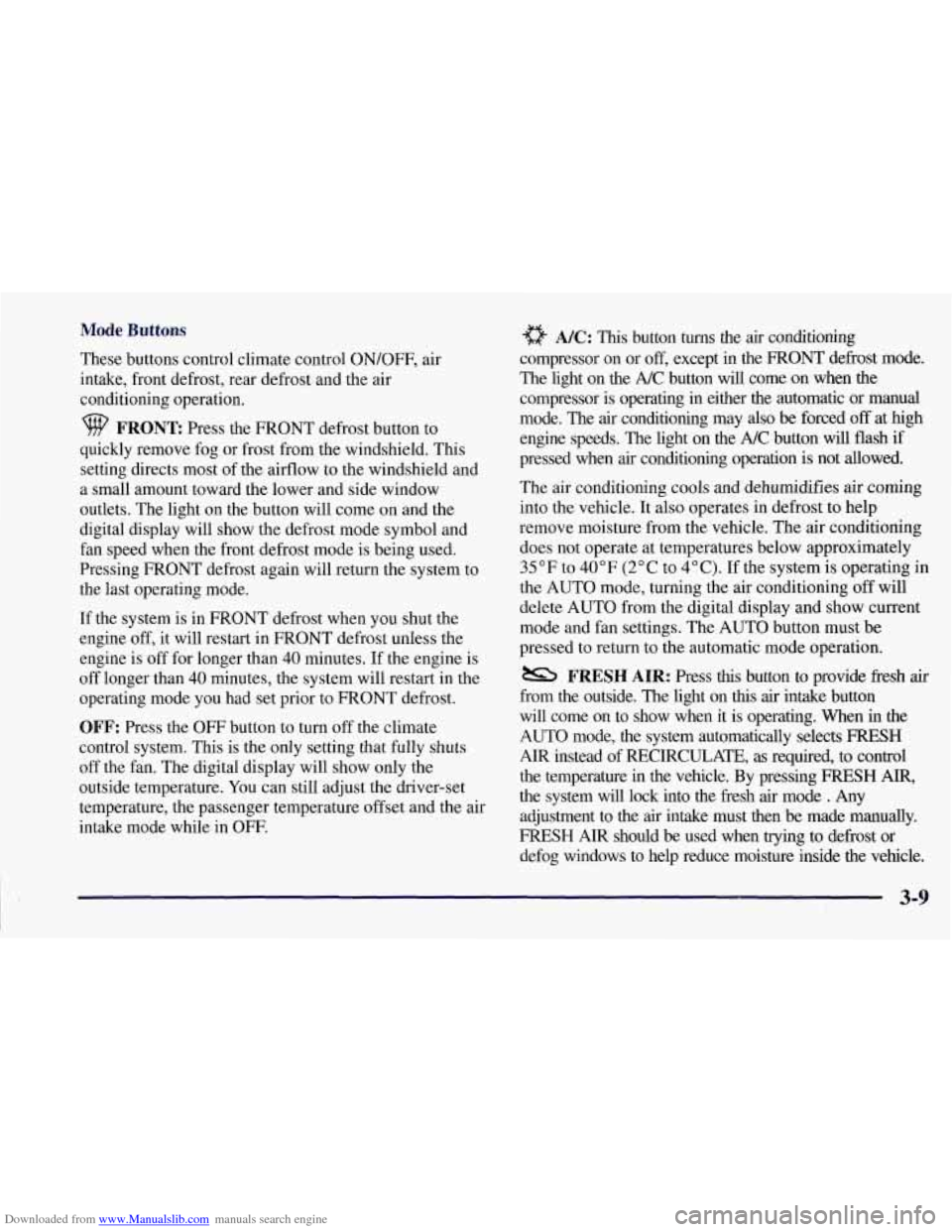
Downloaded from www.Manualslib.com manuals search engine Mode Buttons
These buttons control climate control ON/OFF, air
intake, front defrost, rear defrost and the air
conditioning operation.
FRONT Press the FRONT defrost button to
quickly remove fog or frost from the windshield. This
setting directs most of the airflow to the windshield and
a small amount toward
the lower and side window
outlets. The light on the button will come on and the
digital display will show the defrost mode symbol and
fan speed when the front defrost mode is being used.
Pressing FRONT defrost again will return the system to
the last operating mode.
If the system is in FRONT defrost when you shut the
engine
off, it will restart in FRONT defrost unless the
engine is off for longer than 40 minutes. If the engine is
off longer than 40 minutes, the system will restart in the
operating mode you had set prior to FRONT defrost.
OFF: Press the OFF button to turn off the climate
control system. This is the only setting that fully shuts
off the fan. The digital display will show only the
outside temperature. You can still adjust the driver-set
temperature, the passenger temperature offset and the air
intake mode while in
OFF.
a NC: This button turns the air conditioning
compressor on or
off, except in the FRONT defrost mode.
The light on the A/C button will come on when
the
compressor is operating in either the automatic or manual
mode. The
air conditioning may also be forced off at high
engine speeds. The light on the A/C button will flash if
pressed when
air conditioning operation is not allowed.
The air conditioning cools and dehumidifies
air coming
into the vehicle. It also operates in defrost to help
remove moisture from the vehicle. The air conditioning
does not operate at temperatures below approximately
35°F to 40°F (2°C to 4°C). If the system is operating in
the AUTO mode, turning the air conditioning off will
delete AUTO from the digital display and show current
mode and fan settings. The AUTO button must be
pressed to return to the automatic mode operation.
from the outside. The light on
this air intake button
will come on to show when it is operating. When in
the
AUTO mode, the system automatically selects FRESH
AIR instead of RECIRCULATE, as required, to control
the temperature
in the vehicle. By pressing FRESH AIR,
the system will lock into the fresh air mode . Any
adjustment to the air intake must then be made manually.
FRESH AIR should be used when trying to defrost or
defog windows to help reduce moisture inside the vehicle.
FRESH AIR: Press this button to provide fkesh air
Page 157 of 356
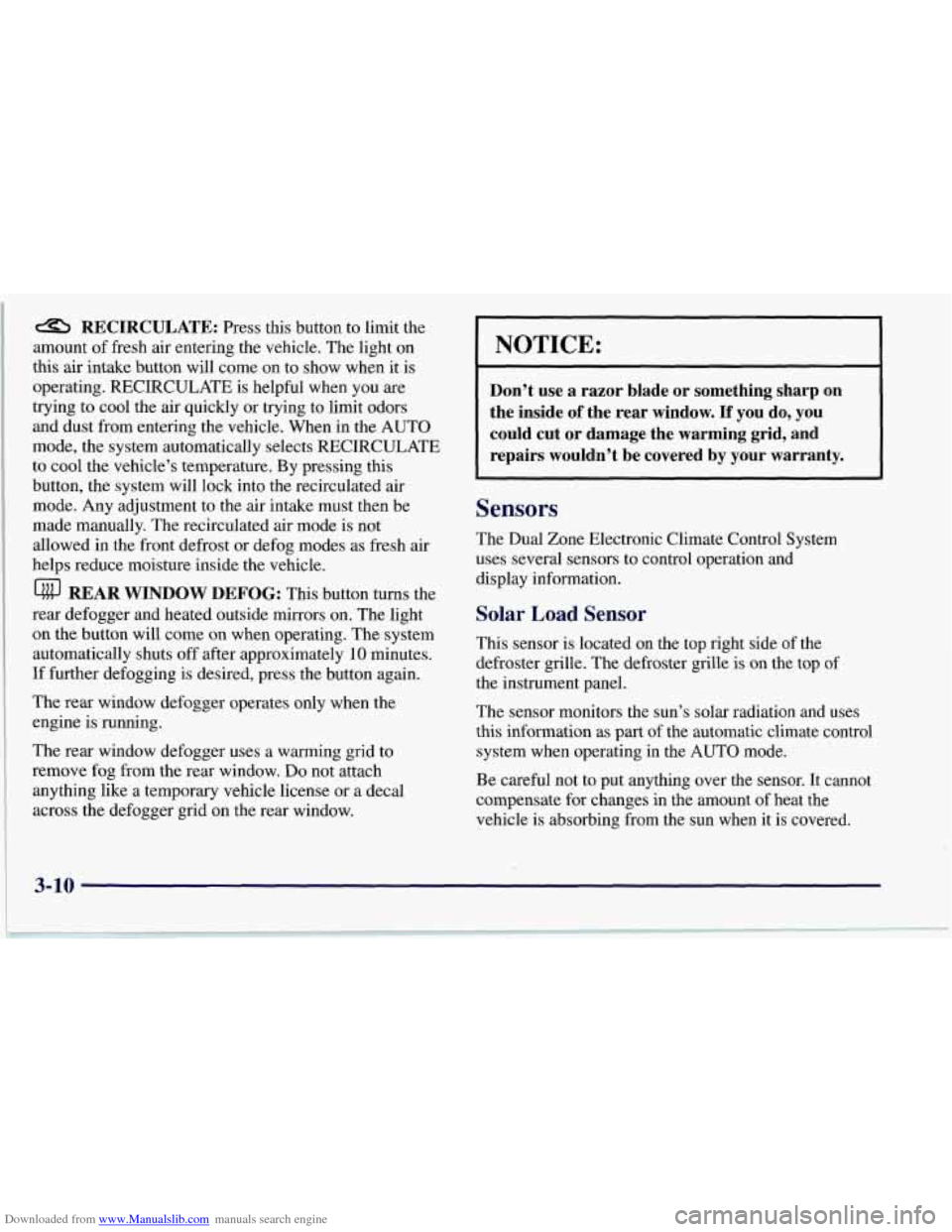
Downloaded from www.Manualslib.com manuals search engine a RECIRCULATE: Press this button to limit the
amount of fresh air entering the vehicle. The light on
this air intake button will come on to show when it is
operating. RECIRCULATE is helpful when you
are
trying to cool the air quickly or trying to limit odors
and dust from entering the vehicle. When in the AUTO
mode, the system automatically selects RECIRCULATE
to
cool the vehicle’s temperature. By pressing this
button, the system will lock into the recirculated air
mode. Any adjustment to the air intake must then be
made manually. The recirculated air mode is not
allowed in the front defrost or defog modes as fresh air
helps reduce moisture inside the vehicle.
Lfttr REAR WINDOW DEFOG: This button turns the
rear defogger and heated outside mirrors on. The light
on
the button will come on when operating. The system
automatically shuts off after approximately
10 minutes.
If further defogging is desired, press the button again.
The rear window defogger operates only when the
engine
is running.
The rear window defogger uses a warming grid to
remove fog from the rear window.
Do not attach
anything like a temporary vehicle license or a decal
across the defogger grid on the rear window.
NOTICE:
Don’t use a razor blade or something sharp on
the inside
of the rear window. If you do, you
could cut or damage the warming grid, and
repairs wouldn’t be covered by your warranty.
Sensors
The Dual Zone Electronic Climate Control System
uses several sensors to control operation and
display information.
Solar Load Sensor
This sensor is located on the top right side of the
defroster grille. The defroster grille is on the top
of
the instrument panel.
The sensor monitors the sun’s solar radiation and uses
this information as part of the automatic climate control
system when operating in the AUTO mode.
Be careful not to put anything over the sensor. It cannot
compensate for changes in the amount of heat the
vehicle
is absorbing from the sun when it is covered.
3-10
Page 158 of 356
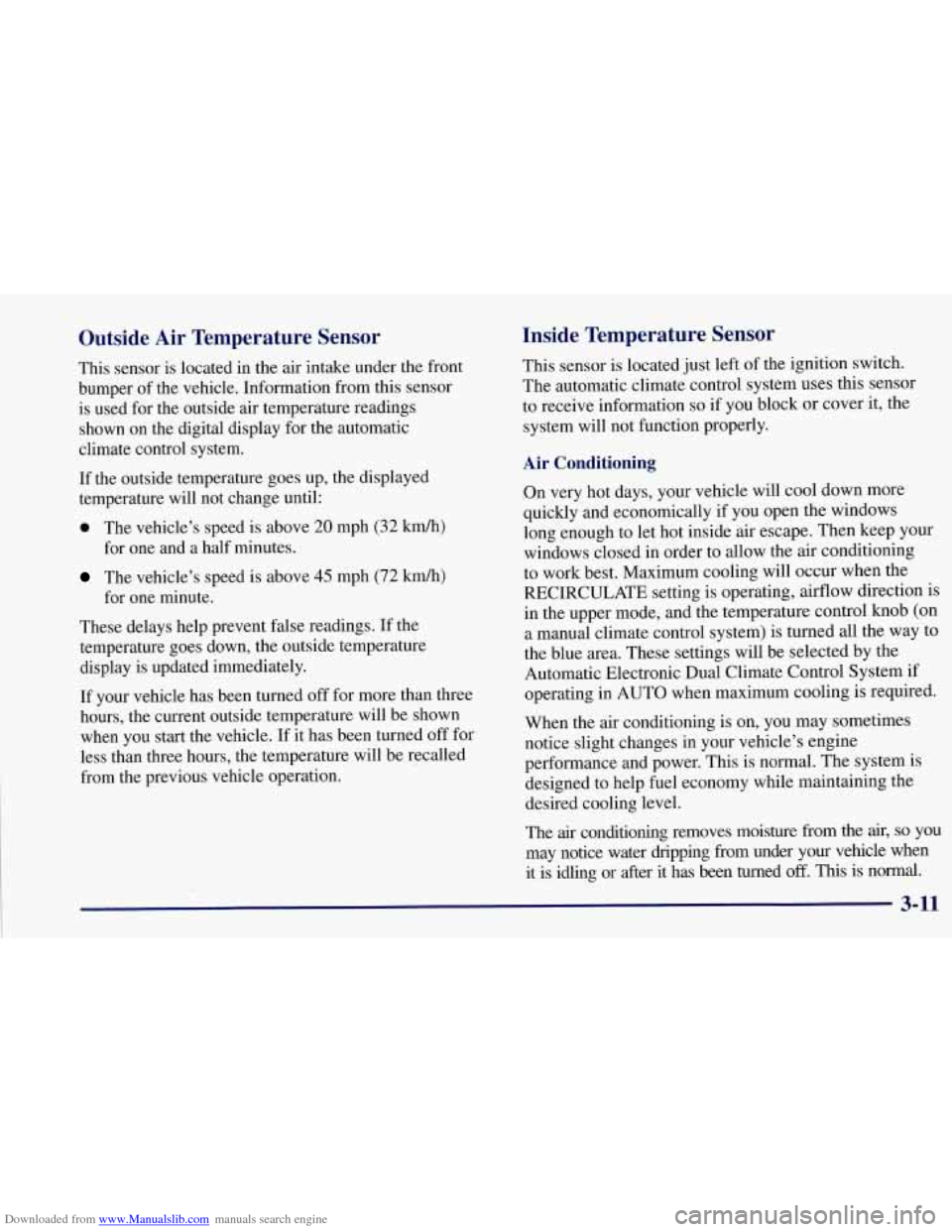
Downloaded from www.Manualslib.com manuals search engine Outside Air Temperature Sensor
This sensor is located in the air intake under the front
bumper of the vehicle. Information from this sensor
is used for the outside air temperature readings
shown on the digital display for the automatic
climate control system.
If the outside temperature goes up, the displayed
temperature will not change until:
0 The vehicle’s speed is above 20 mph (32 km/h)
for one and a half minutes.
The vehicle’s speed is above 45 mph (72 km/h)
for one minute.
These delays help prevent false readings.
If the
temperature goes down, the outside temperature
display is updated immediately.
If your vehicle has been turned off for more than three
hours, the current outside temperature will be shown
when you start the vehicle.
If it has been turned off for
less than three hours, the temperature will be recalled
from the previous vehicle operation.
Inside Temperature Sensor
This sensor is located just left of the ignition switch.
The automatic climate control system uses this sensor
to receive information
so if you block or cover it, the
system will not function properly.
Air Conditioning
On very hot days, your vehicle will cool down more
quickly and economically if you open the windows
long enough to let hot inside air escape. Then keep your
windows closed in order to allow the air conditioning
to work best. Maximum cooling will occur when the
RECIRCULATE setting is operating, airflow direction is
in the upper mode, and the temperature control knob (on
a manual climate control system) is turned all the way to
the blue area. These settings will be selected by the
Automatic Electronic Dual Climate Control System if
operating in AUTO when maximum cooling is required.
When the
air conditioning is on, you may sometimes
notice slight changes in your vehicle’s engine
performance and power. This is normal. The system
is
designed to help fuel economy while maintaining the
desired cooling level.
The
air conditioning removes moisture from the air, so you
may notice water dripping from under your vehicle when
it is idling or after it has been turned
off. This is normal.
3-11
Page 159 of 356
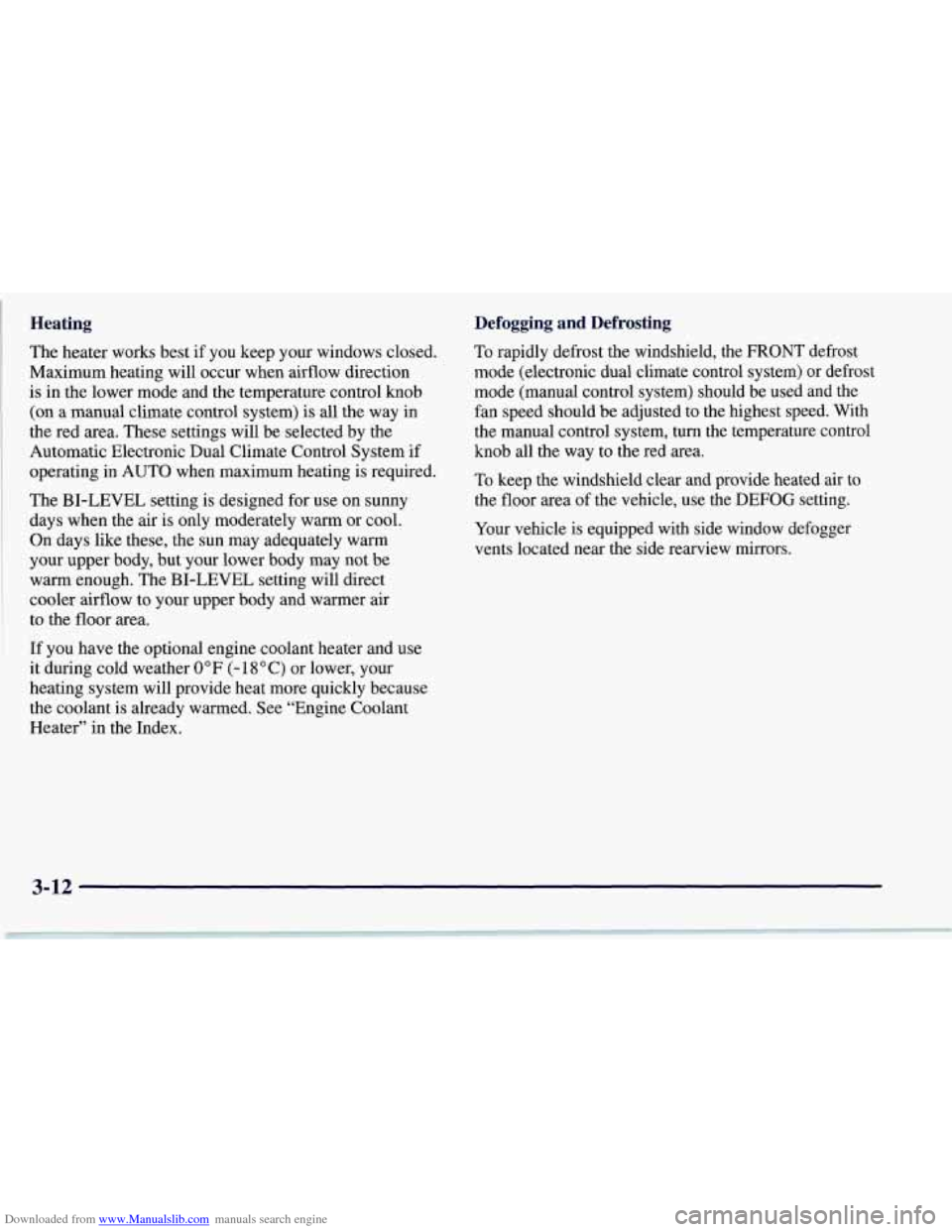
Downloaded from www.Manualslib.com manuals search engine Heating
The heater works best if you keep your windows closed.
Maximum heating will occur when airflow direction
is in the lower mode and the temperature control knob
(on a manual climate control system) is all the way in
the red area. These settings will be selected by the
Automatic Electronic Dual Climate Control System if
operating in AUTO when maximum heating is required.
The BI-LEVEL setting is designed for use on sunny
days when the air is only moderately warm or cool.
On days like these, the sun may adequately warm
your upper body, but your lower body may not be
warm enough. The BI-LEVEL setting will direct
cooler airflow to your upper body and warmer air
to the floor area.
If you have the optional engine coolant heater and use
it during cold weather
0°F (- 18OC) or lower, your
heating system will provide heat more quickly because
the coolant is already warmed. See “Engine Coolant
Heater” in the Index.
Defogging and Defrosting
To rapidly defrost the windshield, the FRONT defrost
mode (electronic dual climate control system) or defrost
mode (manual control system) should be used and the
fan speed should be adjusted to the highest speed. With
the manual control system,
turn the temperature control
knob all the way to the red area.
To keep the windshield clear and provide heated air to
the floor area of
the vehicle, use the DEFOG setting.
Your vehicle is equipped with side window defogger
vents located near the side rearview mirrors.
3-12